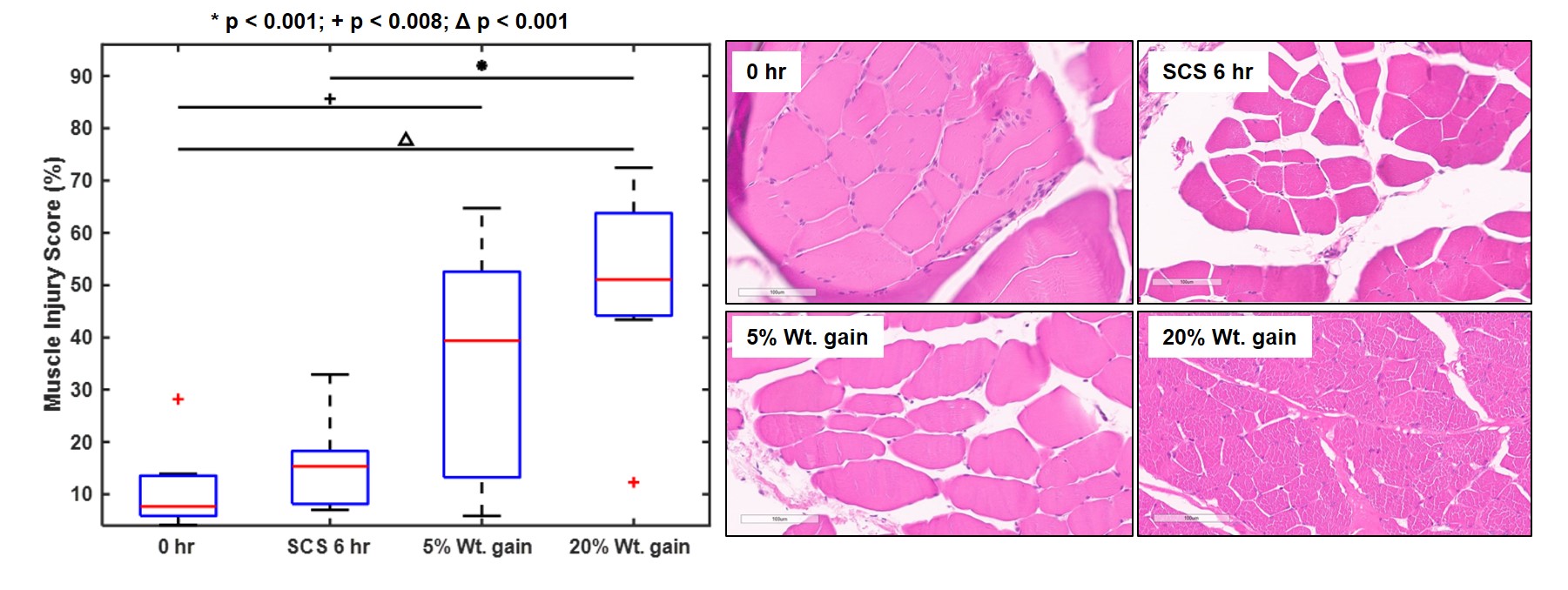Determining Endpoint Criteria in Ex Vivo Normothermic Limb Perfusion (EVNLP)
1Plastic Surgery, Cleveland Clinic, Cleveland, OH, 2Department of Nutrition, School of Medicine, Case Western Reserve University, Cleveland, OH, 3Department of Gastroenterology, Cleveland Clinic, Cleveland, OH
Meeting: 2021 American Transplant Congress
Abstract number: LB 40
Keywords: Monitoring, Perfusion solutions, Preservation
Topic: Basic & Clinical Science » VCA
Session Information
Location: Virtual
*Purpose: There are no established criteria for discontinuing EVNLP before irreversible muscle and endothelial cell damage occur. This study aimed to evaluate weight gain as a real-time clinical indicator of injury during EVNLP
*Methods: Sixteen forelimbs were procured from Yorkshire pigs and preserved using EVNLP (37°C) (n=8) or static cold storage (SCS 4°C) (n=8). An oxygenated perfusate containing oxygen carrier HBOC-201 was used. EVNLP continued for 24 hours or until systolic perfusate pressure was ≥115 mmHg, fullness of compartments or a reduction of tissue oxygen saturation by 20% were observed. Limb weight, contractility, hemodynamic parameters, perfusate electrolytes, metabolites and gases were recorded and analysed. Biopsies of biceps muscles were collected 6 hourly, and muscle injury scores (MIS) calculated. Outcomes were compared at 2%, 5%, 10%, and 20% limb weight gain. Pearson’s correlation between parameters, t-test or ANOVA followed by Tukey post hoc pairwise comparisons were performed.
*Results: EVNLP lasted 20±3 hours. Weight gain was observed after 13±5 h (2%), 15±6 h (5%), 16±6 h (10%), and 19±4 h (20%). Weight gain correlated positively with MIS (r=0.92, p<0.01), perfusate potassium (r=0.81, p<0.01) and mean perfusate pressure (r=0.63, p<0.01). Weight correlated negatively with contractility (r=-0.71, p<0.01). At 5% weight gain, significantly higher MIS (p<0.01), perfusate potassium (p=0.03), and lactate (p=0.02) were recorded compared to the baseline. Mean MIS at 5% weight gain was not significantly different from SCS limbs at 6 hours (p=0.07). Arterial resistance increased over time (r=0.55, p<0.05) and at 20% weight gain was significantly higher (p=0.02) than at 5% weight gain, the latter being not significantly different from baseline (p=0.28). No significant difference was observed between glucose consumption (p=0.48), oxygen uptake rate (p=0.94) or creatine kinase (p=0.30) at the different weight levels. Median muscle contractility was 4 (1-5) at 5% weight gain, which decreased to 3 (0-4) and 2 (0-2) at 10% (p=0.32) and 20% (p=0.24), respectively.
*Conclusions: Weight gain precedes increasing arterial resistance. Muscle injury in limbs at 5% weight gain is similar to that of limbs preserved at 4°C for 6 h (standard cold ischemia time) and therefore 5% weight increase may serve as a criterion for discontinuation of EVNLP.
To cite this abstract in AMA style:
Pandey SK, Meyers A, Sadeghi P, Kopparthy V, Xia T, Brunengraber H, Dasarathy S, Rampazzo A, Gharb BBassiri. Determining Endpoint Criteria in Ex Vivo Normothermic Limb Perfusion (EVNLP) [abstract]. Am J Transplant. 2021; 21 (suppl 3). https://atcmeetingabstracts.com/abstract/determining-endpoint-criteria-in-ex-vivo-normothermic-limb-perfusion-evnlp/. Accessed December 25, 2025.« Back to 2021 American Transplant Congress

